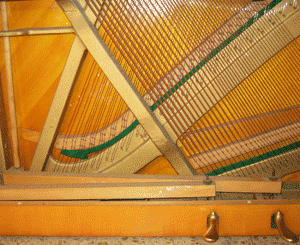Piano Techniques - How Does A Piano Work?
I know many piano students who have been playing the piano for years and have no idea how the piano works. You can play the piano without understanding its mechanism of course, but in my opinion, if you love playing the piano you should understand how the various parts inside the piano help to acquire the different piano techniques in depth through knowing the inside of the piano. So let's get to know the inside of the piano! The first thing you need to do is to stand up and open the cover of the piano. Once you've opened the piano you will see strings, hammers and dampers. Now, play a key on the keyboard while you look inside. Try the black keys and the white ones as well, and you will see that inside the piano there is actually NO difference between the ebony and ivory keys (which for some of you might come as a surprise, right?) The piano actionThe Hammer
Each piano key is connected to a hammer covered with felt. When you play a key, the hammer strikes the string, causing it to vibrate, and that's how the sound is produced. It is simple, isn't it? Well, the mechanics behind this is a little more interesting. If the key was connected to the hammer by a simple lever, then the hammer would have continued touching the string as long as you held the key. This would have caused the string to stop vibrating immediately. It's like the strings on the guitar - if you pluck on one of them, you have to take your finger off the string, otherwise it stops vibrating. Let's try and explain how this piano technique works... First of all try and play a key, holding it down for a few seconds. What do you see? The hammer strikes the string and immediately bounces back a little bit so that the string is free to vibrate. How does this piano technique work? Piano Technique - Escapement mechanism!
The piano action involves a special "escapement mechanism": Just an instant before the hammer strikes the string, the hammer "escapes" from its connection with the key; hence it bounces back a little bit after striking the string. When you release the key, the hammer goes back to its original position and is ready for the next time you play it.. The special double-repetition mechanism of the grand pianoIn grand pianos the action is more complicated. It is based on a double-repetition mechanism: After the hammer strikes the string, the lever catches the hammer again close to the string, and by that enables you to play key again immediately. Let me try and explain in a different way, In upright pianos, if you want to play the same key again, you have to release it almost up to its original position, while in grand pianos you just have to lift up the key a little bit in order to play it again. This special mechanism enables various piano technique the envolve very fast repetitions on the same key and fast trills. The Damper
Have you noticed this unique piano technique? As long as you continue holding down on the key, the sound will echo, but once you release the key, the sound will stop immediately. How come? This piano technique works as follows: Each key is connected to a damper. The damper's purpose is to prevent vibration of the strings by pushing down on them. When you play a key, the damper is lifted off and the related string is then free to vibrate. As long as you hold the key down, the string will continue to vibrate, but when you release the key, the damper falls back on the string stopping its vibration. The sound, of course, will immediately stop. The "highest" strings (those on the right side of the piano) usually do not have dampers at all because their vibrations stop after a short time. In the picture above you can see a damper that touches two strings, and another one that touches three strings. Strange ha? - The following explanation about the strings will help you to understand this piano technique. Here is a nice demonstration of the piano action:
The StringsStrings come in various lengths, thicknesses, and materials. Why are some of the strings longer than the others? Why are some of them thicker? Here is the explanation: When a string vibrates, it produces a sound. The strings on the right of the piano produce a "high" thin sound, while the ones on the left produce a "low" deep sound. Piano Technique - What are "high" and "low" sounds? Don't get confused with the terms "high" and "low" for a sound. We're not talking about the volume (loudness); A "high" sound is like the one which is produced by mosquitoes, bees, or an opera soprano singer - a high-pitched sound. A "low" sound is like the one produced by elephants, the rumbling of thunder, or an opera bass singer - a low pitched sound. The height of the sound is determined by the frequency of the string. What is frequency? I'll try to explain this in simple words, although that is a term which comes from the world of physics: Frequency is in fact the number of times the string vibrates when they are hit by the hammer. When a string vibrates, it actually moves back and forth a number of times per second. It reminds us of the movement of a wave. . When the frequency of the string is very rapid, the sound you hear will be very "high" (as I said before, high doesn't mean it is loud). Strings on the left of the piano have lower frequencies than the strings on the right, so the sound that they produce is "lower". For example, the frequency of the string at the extreme left of the piano is only about 30, and the sound coming out is like that of a monster, while at the other end of the piano the frequency is about 4000, and the sound coming out there is very sharp. We're getting closer to understanding the difference between the strings... So as far as it concerns for piano technique there are four properties of a string that affect their frequency: 1. Length - the shorter the string - the higher its frequency - and the higher its sound. Now, watch the strings of the piano - as you go to the right end, they become shorter. Why? The shorter the string - the higher its frequency - and the higher its sound. Why are the bass strings thicker than the other strings? If the bass strings of the piano had the same diameter as the other strings, they would have been more then 20 feet long! In that case we could not have a piano at home (That's a pity).
We are lucky that the piano designers had solved this problem by changing two parameters of the bass strings: You can probably see that the bass strings have a copper wire spiraling along their length. The result you get is a string which has almost the same length as other strings, but much thicker and heavier. It will vibrate slower, and thus will produce a "lower" sound. Wait a minute; this is clear, but why does the piano have only one or two strings for each key in the bass section and three strings in the rest of the piano? The bass strings, as we said before are thicker, and their mass is bigger, hence the volume of the sound they produce is louder than the other strings. In order to balance the volume between the notes in the bass section and the other notes, more strings are added to the other keys. The hammer hits two strings or three and the volume is coupled, or tripled. By that we get a balanced piano.


Why are the strings positioned diagonally? 
If the strings where placed vertically to the keys they would be much shorter. Longer strings increase the quality of the sound, so in order to utilize the size of the piano, the strings are positioned diagonally. The Pin block
The pin block is a big piece of wood at the back of the piano which holds the tuning pins. Soundboard and the Bridge

The bridge transfers the vibration of the strings to the soundboard Hammers, dampers and strings are not enough to produce the sound of the piano. If there were only strings which vibrate, the sound would be weak and poor. In the image below you can see that the strings are connected to the Bridge. The piano strings, like those of a guitar or violin, press down on the bridge which conducts their vibration to the soundboard. The soundboard is a large piece of wood, and is actually the heart of the piano. It has two main purposes: 1) To amplify the volume. Piano builders invest much effort when building the soundboard, processing high quality wood to make sure that the sound of the piano will be perfect. The Frame (Plate, Harp)More than 200 strings create tremendous pressure on the piano. In the past, the frame of the piano was made of wood, which would bend under the high string tension, and cause the strings to go out of tune. Since the mid 1800's, the frame is made of cast iron which holds the hundreds of parts of the piano much better, and makes it an instrument that may last for many years. In grand pianos - where the strings are much longer than upright pianos, the pressure could be about 30 tons - much like the weight of two semi-trailers... WOW!! The Pedals
The right pedal (The damper pedal)When you hold the right pedal down, and play a tone its sound continues even after you release the key (until you lift your foot from the pedal). Let's understand this piano technique. When the pedal is pressed, all the dampers are detached from the strings, so, when a string is hit by the hammer it continues to vibrate until you release the pedal. Why is the sound of the piano so much richer and fuller when you press the pedal? I can only explain the basic principle of this piano technique here, because the answer is in physics, and we would like to focus on getting to know piano techniques and the mechanics of the inside of the piano. When a string vibrates it causes other nearby strings to vibrate as well. (That's a law in physics). So, when you press the pedal, all the strings are free to move. Pressing a key will vibrate not only the related string, but other strings as well. That's how this piano technique works! This is the reason behind this special sound effect! You press one key, and other strings will move as well! Which strings will move, and which won't? Well, this isn't really the place to give an explanation...!!! The left pedal (Una Corda pedal, or the Soft pedal)Now try the left pedal. Watch the hammers. What do you see? You may see one of the following things happening depending on the kind of piano you have: The middle pedal (Sostenuto pedal)In most cases this pedal lifts a cloth or a piece of felt and places it between the hammers and strings. This means that the sound is muted, and you can play even after midnight without disturbing the neighbors thanks to this awsome piano technique! In grand pianos this pedal can sustain only the notes that are pressed while using this pedal, thus you can sustain only selected strings and continue playing with both hands on other keys while some strings still vibrate and produce sound what allows new fascinating piano techniques. In other instances, this pedal can lift only the bass dampers. In this case you can use the following piano technique. You play a bass note, keeping it in the background for as long as the pedal is pressed down, and you are free to continue playing the piano with both hands. A few last words about piano technique... 
I think that understanding how the piano technique is not only fascinating, but also can improve your playing. It's like an athlete: He can be excellent, but learning how his body works can be helpful and improve his achievements. |
How To Play Piano by ChordsTHE FAST AND EASY WAY TO LEARN PIANO! The Ultimate Piano by Chords Learning Kit "Your entire site is simply fantastic. I really loved it. Now I am learning the basics of piano by myself, with your really great help. Thank you very much!" Jaime C. from Brazil "I only started to play about six weeks ago but the last hour of watching your videos about chord progressions has been something of a revelation. You're brilliant!!!!" Stephen Roberts from U.S.A "I'm a beginning keyboard player and your video's are an excellent guide. You're absolute not in a hurry, and take time to explain. I'm sure I'll follow all your lessons to get the hang of playing the piano/keyboard!" Wouter E. from the Netherlands "Thanks for all your work ( tuto and others ). You're doing a really great job, You're the best internet teacher I know." Anthony Hassen Cohen from France |
|||
|
Enjoy This Site?
Then why not use the button below, to add us to your favorite bookmarking service? |
||||
|
| Homepage |
Site Map |
Just Added |
Buy Us Coffee! |
Sign up / Freebies |
Recommended Products |
Articles & Reviews |
Blog |
Beginners Course |
Accompaniment Course |
Notes Lessons |
Playing Technique | Chords | Theory| Tutorials | Sheets | Forum | Piano Videos | History | Piano Stuff| Keyboards and Pianos| |
||||
|
Copyright piano-play-it.com © 2008-2017. | ||||














